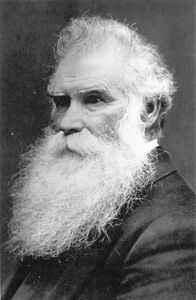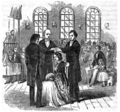Portal:Latter Day Saint movement
|
Welcome to the portal of The Latter Day Saint movement
Introduction The Latter Day Saint movement (also called the LDS movement, LDS restorationist movement, or Smith–Rigdon movement) is the collection of independent church groups that trace their origins to a Christian Restorationist movement founded by Joseph Smith in the late 1820s. Collectively, these churches have over 17 million nominal members, including over 17 million belonging to the Church of Jesus Christ of Latter-day Saints (LDS Church), 250,000 in Community of Christ, and several other denominations with memberships generally ranging in the thousands of members. The predominant theology of the churches in the movement is Mormonism, which sees itself as restoring again on Earth the early Christian church; their members are most commonly known as Mormons. An additional doctrine of the church allows for prophets to receive and publish modern-day revelations. A minority of Latter Day Saint adherents, such as members of Community of Christ, have been influenced by Protestant theologies while maintaining certain distinctive beliefs and practices including continuing revelation, an open canon of scripture and building temples. Other groups include the Remnant Church of Jesus Christ of Latter Day Saints, which supports lineal succession of leadership from Smith's descendants, and the more controversial Fundamentalist Church of Jesus Christ of Latter-Day Saints, which defends the practice of polygamy. (Full article...) General images -The following are images from various Latter Day Saint movement-related articles on Wikipedia.
Selected articleLatter Days is a 2003 American romantic comedy drama film about the relationship between a closeted Mormon missionary and his openly gay neighbor. The film was written and directed by C. Jay Cox and stars Steve Sandvoss as the missionary, Aaron, and Wes Ramsey as the neighbor, Christian. Joseph Gordon-Levitt appears as Elder Ryder, and Rebekah Johnson as Julie Taylor. Mary Kay Place, Khary Payton, Erik Palladino, Amber Benson, and Jacqueline Bisset have supporting roles. Latter Days premiered at the Philadelphia International Gay & Lesbian Film Festival on July 10, 2003, and was released in various states of USA over the next 12 months. Later the film was released in a few other countries and shown at several gay film festivals. It was the first film to portray openly the clash between the principles of the Church of Jesus Christ of Latter-day Saints and homosexuality, and its exhibition in some U.S. states was controversial. Various religious groups demanded that the film be withdrawn from theaters and video stores under boycott threats. (Full article...) Selected locationThe Nauvoo Temple was the second temple constructed by the Church of Jesus Christ of Latter Day Saints. The church's first temple was completed in Kirtland, Ohio, United States, in 1836. In the winter of 1846, when the main body of the church was forced out of Nauvoo, the church attempted to sell the building, finally succeeding in 1848. The building was damaged by arson and a tornado before being demolished. In 1937, The Church of Jesus Christ of Latter-day Saints (LDS Church) reacquired the lot on which the original temple had stood. In 2000, the church began to build a temple on the original site with an exterior that is a replica of the first temple, but whose interior is laid out like a modern Latter-day Saint temple. On June 27, 2002, a date that coincided with the 158th anniversary of the death of Joseph and Hyrum Smith, the temple was dedicated by the LDS Church as the Nauvoo Illinois Temple. (Full article...)
Selected schismatic historiesCommunity of Christ, known from 1872 to 2001 as the Reorganized Church of Jesus Christ of Latter Day Saints (RLDS), is an American-based international church, and is the second-largest denomination in the Latter Day Saint movement. The church reports approximately 250,000 members in 1,100 congregations in 59 countries. The church traces its origins to Joseph Smith's establishment of the Church of Christ on April 6, 1830. His eldest son Joseph Smith III formally accepted leadership of the church on April 6, 1860 in the aftermath of the 1844 death of Joseph Smith. Community of Christ is a Restorationist faith expression. Still, various practices and beliefs are congruent with mainline Protestant Christianity. While it generally rejects the term Mormon to describe its members, the church abides by a number of theological distinctions unusual outside Mormonism, including but not limited to: ongoing prophetic leadership, a priesthood polity, the use of the Book of Mormon and the Doctrine and Covenants as scripture, belief in the cause of Zion, the building of temples, and an interpretation of the Word of Wisdom. In many respects, the church differs from the larger Church of Jesus Christ of Latter-day Saints (LDS Church) and most other Latter Day Saint denominations in its religious liberalism, belief in the traditional conception of the trinity (as opposed to a godhead of three separate and distinct beings), and rejection of exaltation and the plan of salvation. Salvation is considered a personal matter and not subject to dogma, but salvation by grace alone is emphasized. The church considers itself to be non-creedal and accepts people with a wide range of beliefs. Church teachings emphasize that "all are called" as "persons of worth" to "share the peace of Christ". (Full article...) OutlinesRelated portalsKey biographiesWilliam Bickerton (January 15, 1815 – February 17, 1905) was a leader in the Latter Day Saint movement after the 1844 succession crisis. In 1862, Bickerton became the founding president of the church now known as The Church of Jesus Christ (Bickertonite), which is one of many churches that claim to be a continuation of the Church of Christ founded by Joseph Smith Jr in 1830. (Full article...)
Selected image In the Mormon fundamentalist movement, the 1886 Revelation is the text of a revelation said to have been received by John Taylor, third President of The Church of Jesus Christ of Latter-day Saints (LDS Church), that is claimed to restate the permanence of the principle of plural marriage.
Did you know (auto generated)
Selected Anniversaries
Selected quote
TopicsFeatured contentCategoriesWikiProjectsAssociated WikimediaThe following Wikimedia Foundation sister projects provide more on this subject:
Discover Wikipedia using portals | ||||||||||





































